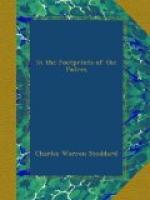One frequently meets a travelling bazaar—a coolie with his bundle of fans and bric-a-brac, wandering from house to house, even in the suburbs; and the old fellows, with a handful of sliced bamboos and chairs swinging from the poles over their shoulders, are becoming quite numerous; chair mending and reseating must be profitable. These little rivulets, growing larger and more varied day by day, all spring from that great fountain of Asiatic vitality—the Chinese Quarter. This surface-skimming beguiles for an hour or two; but the stranger who strolls through the streets of Chinatown, and retires dazed with the thousand eccentricities of an unfamiliar people, knows little of the mysterious life that surrounds him.
Let us descend. We are piloted by a special policeman, one who is well acquainted with the geography of the quarter. Provided with tapers, we plunge into one of the several dark recesses at hand. Back of the highly respectable brick buildings in Sacramento Street—the dwellings and business places of the first-class Chinese merchants—there are pits and deadfalls innumerable, and over all is the blackness of darkness; for these human moles can work in the earth faster than the shade of the murdered Dane. Here, from the noisome vats three stories underground to the hanging gardens of the fish-dryers on the roofs, there is neither nook nor corner but is populous with Mongolians of the lowest caste. The better class have their reserved quarters; with them there is at least room to stretch one’s legs without barking the shins of one’s neighbor; but from this comparative comfort to the condensed discomfort of the impoverished coolie, how sudden and great the change!
Between brick walls we thread our way, and begin descending into the abysmal darkness; the tapers, without which it were impossible to proceed with safety, burn feebly in the double night of the subterranean tenements. Most of the habitable quarters under the ground are like so many pigeon-houses indiscriminately heaped together. If there were only sunshine enough to drink up the slime that glosses every plank, and fresh air enough to sweeten the mildewed kennels, this highly eccentric style of architecture might charm for a time, by reason of its novelty; there is, moreover, a suspicion of the picturesque lurking about the place—but, heaven save us, how it smells!
[Illustration: “Rag Alley” in Old Chinatown]
We pass from one black hole to another. In the first there is a kind of bin for ashes and coals, and there are pots and grills lying about—it is the kitchen. A heap of fire kindling wood in one corner, a bench or stool as black as soot can paint it, a few bowls, a few bits of rags, a few fragments of food, and a coolie squatting over a struggling fire,—coolie who rises out of the dim smoke like the evil genii in the Arabian tale. There is no chimney, there is no window, there is no drainage. We are in a cubic sink, where we can scarcely stand erect. From the small door pours a dense volume of smoke, some of it stale smoke, which our entry has forced out of the corners; the kitchen will only hold so much smoke, and we have made havoc among the cubic inches. Underfoot, the thin planks sag into standing pools, and there is a glimmer of poisonous blue just along the base of the blackened walls; thousands feed daily in troughs like these!




